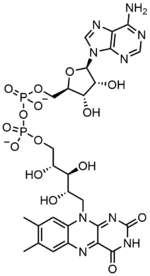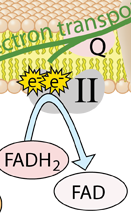FAD - Flavin Adenine Dinucleotide
An important mechanism in cellular respiration is the transfer of energy to the molecule flavin adenine dinucleotide (FAD) to convert it to FADH2 This is a process of reduction which stores the energy in high electron states in the FADH2. Much of the energy transfer in the cell involves redox reactions such as this, and FAD is called a "redox cofactor" or a coenzyme. The reduced coenzyme FADH2 contributes to oxidative phosphorylation in the mitochondria. FADH2 and NADH can be considered to be like "charged batteries" from having accepted electrons and a proton or two. FADH2 is reoxidized to FAD, which makes it possible to produce two molecules of the universal energy carrier ATP. The source of the energized FADH2 in the cell is generally the TCA cycle. |  |
FAD is derived from riboflavin, or vitamin B2. |  |
| FAD wiki |
Organic chemistry concepts
Chemistry concepts
Reference
Karp
Ch 3
| HyperPhysics*****Chemistry | R Nave |